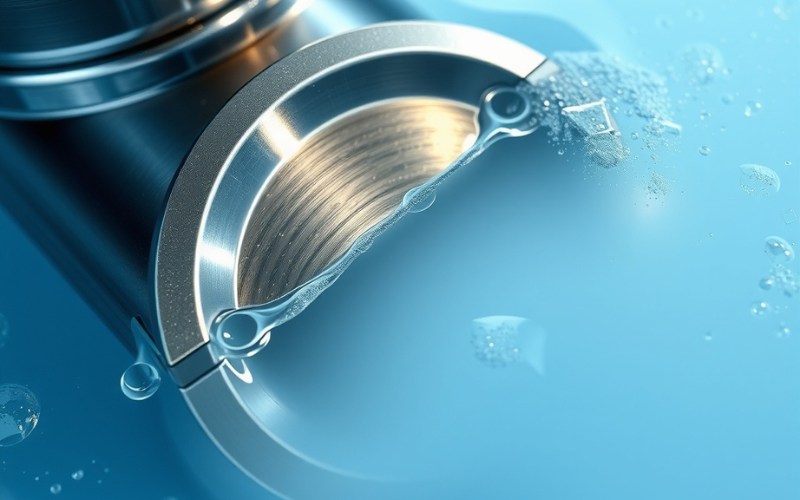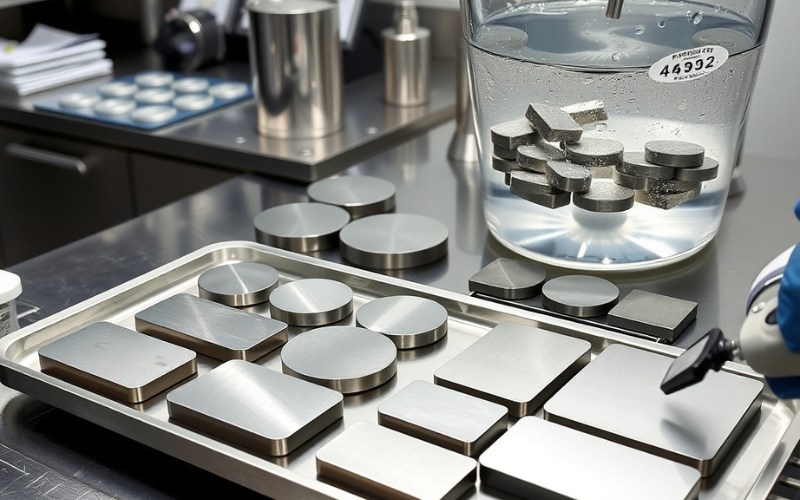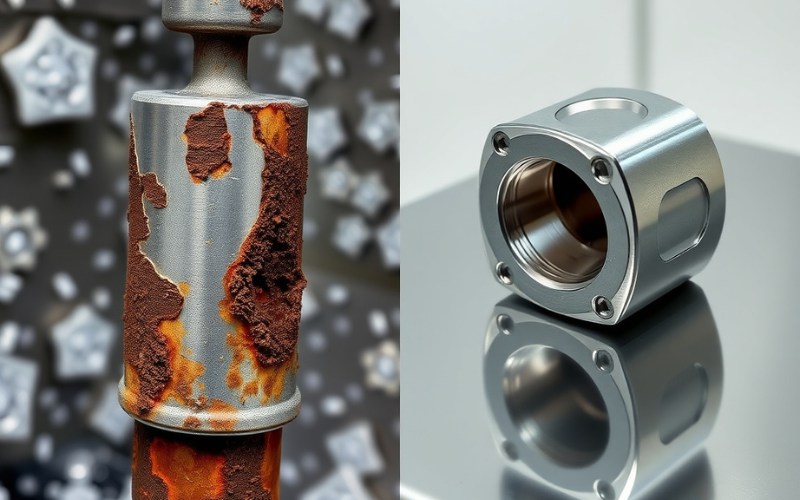Lassen Sie sich von Istar mit unserer Erfahrung und unserem Know-how beim Start Ihres Projekts unterstützen!
Laden Sie Ihre Designdateien und Produktionsanforderungen hoch und wir melden uns innerhalb von 30 Minuten bei Ihnen!

Rust, also called corrosion, can damage costly parts and stop a whole machine from working. That is why I want to talk with you about passivation. It is a special cleaning method that is done on stainless steel. It helps the steel become much better at fighting corrosion. This article will show you everything I have learned about the passivation process. You will learn how it works and why it is so important. You will also learn how you can know for sure that it was done the right way. Knowing this can save you lots of time and money. That is always a good thing.
Let me explain it in a simple way. In short, passivation is a chemical cleaning process. It is a kind of metal finishing. It is used to help a material, most often stainless steel, fight off corrosion better. You might hear it called a finishing process to prevent corrosion. The word “passive” gives you a clue. The main purpose of passivation is to make the top layer of the steel not react as much. We call this being passive. It helps a protective layer to form that stops rust before it can even begin.
Some people think passivation is just a special kind of cleaning. It is much more than that. It is a chemical treatment. It changes the very top part of the metal surface. This process is similar to some other treatments. But passivation is special. It does not add a coating. Instead, it makes the steel’s own natural ability to resist corrosion even better. Because of this, the good effects of passivation last a very long time. Proper passivation is a very important step to make sure any stainless steel part has a long life.
The whole idea behind the passivation of stainless steel is to make something we call a passive film. This is a very thin, invisible layer on the surface that works like a shield. You can think of it as armor for your steel. This oxide layer or passivation film is the reason stainless steel is so good at stopping rust. The passivation process helps to make this shield strong and even all over. It is a very important passivation step in making things.
I have seen this happen many times. A workshop gets a new, shiny machine that is full of stainless steel parts. But if those parts were not properly passivated, they can start to show little spots of rust. Why does this happen? People think stainless steel is not able to rust. Well, stainless steel naturally resists corrosion, but it is not magic. When you make things by cutting, bending, or shaping stainless steel, very small bits of iron get spread on the surface. This is a big problem for stainless steel parts after machining.
This free iron is a big type of contaminant. It messes up the natural protective layer of the stainless steel. These tiny iron spots are where corrosion gets started. The passivation process is so important because its main job is to take away this free iron from the surface. By getting rid of this contaminant, we let the stainless steel build up its natural defense. Without passivation, you are leaving your expensive steel parts open to attack. The passivation of stainless steel parts is not something you can choose to skip. It is a must-do.
Think about it like this. You build a lovely house but leave the doors and windows open in a bad storm. That is what it is like to use stainless steel without passivation. You have a great material, but it is not fully protected. The passivation offer is clear: a little bit of work now stops a lot of expensive corrosion from happening later. This passivation makes a huge difference in the life of the steel.
This is where the science part comes in, but I will keep it easy to understand. The special part in stainless steel is a material called chromium. This alloy has a good bit of chromium mixed in with the steel. Chromium has little or no chemical reactivity compared to iron. It is this lack of chemical reactivity that we want to use. The passivation process is a chemical dissolution method. This means it uses an acid bath to melt away the “bad” stuff and leave the “good” stuff behind.
When we put a stainless steel part into a passivation bath, the acid goes to work. This acid is usually nitric acid or citric acid. The first thing this acid solution does is eat away all the free iron bits that are stuck to the surface. It cleans them off all the way. After the iron is gone, the real magic starts to happen. The chromium that is part of the stainless steel alloy is now out in the open. It can touch the oxygen in the bath and in the air.
Being out in the open causes a chemical reaction. The chromium connects with oxygen and forms a thin, strong, and steady layer of chromium oxide. This layer is the protective oxide layer. We also call it the passive film. It seals the top of the steel. This protects the iron inside the alloy from ever touching air and water, which is what makes rust. The passivation itself is what helps the formation of the oxide layer.

For a long time, the normal way to do passivating was with nitric acid. I have done a lot of passivation work using a nitric acid bath. It is very good at its job and works well. The immersion of stainless steel in nitric acid quickly takes away ferrous contaminants. It also helps to form a great oxide film. Sometimes, a chemical known as sodium dichromate is added. This makes the nitric acid even stronger.
But, there are some bad things about using nitric acid. It is a strong chemical and can make harmful smoke. Also, if sodium dichromate is used, it can make a toxic hexavalent chromium compound. This is very bad for people and for nature. This is why, in the last few decades, many people have changed to citric acid passivation. The use of citric acid for the passivation process is now very common.
Citric acid is much safer to work with. It is a natural acid that you can find in fruits like lemons and oranges. It does the same job as nitric acid. It takes away the free iron. But it does this job without the dangerous side effects. It is better for nature and for the people who do the passivation work. In a lot of cases, citric acid works just as well as concentrated nitric acid. Sometimes, it even works better.
Here is a simple table to compare them:
| Merkmal | Nitric Acid Passivation | Citric Acid Passivation |
|---|---|---|
| How Well It Works | Works very well, has been used for a long time. | Works very well, often better for some types of steel. |
| Sicherheit | Can be dangerous, makes smoke. | Much safer, breaks down naturally. |
| For Nature | Can make dangerous trash. | Friendly to the environment. |
| Kosten | Chemicals can be costly to buy and get rid of. | Usually a better value for the money. |
This is a question I hear a lot. The easy answer is no. The passivation process I am talking about is made just for stainless steel. You cannot take a piece of plain carbon steel, put it in an acid bath, and think it will become rust-proof. It just will not work like that. In fact, putting plain steel in that acid would only hurt it.
The reason passivation works on stainless steel is because of what it is made of. Like I said before, stainless steel is an alloy. It has a lot of chromium in it. Plain steel does not have a lot of chromium. Without the chromium, there is nothing there to make the protective chromium oxide layer. The passivation bath would just eat away at the plain steel.
So, you should remember that passivation is a treatment just for stainless steel and other metals that have this ability to heal themselves. For other kinds of steel, there are different ways to stop corrosion. These include painting, galvanizing, or putting on a conversion coating. But that is a different story for another time. The passivation we are talking about is all about making the natural powers of stainless steel even better.
This is the most important question of all. After you have done all the work, how do you know if the passivation worked well? You do not want to just cross your fingers and hope it worked. There are tests you can do to check if the effectiveness of the process was good. A stainless steel part that has been properly passivated should have a clean surface with little or no chemical reactivity.
For an easy check, you can use a copper sulfate liquid. If you put a drop on the surface and it turns a copper color, it means there is still free iron there. This tells you the passivation did not work. A better test that you can trust is the salt spray test. In this test, the passivated parts are put into a special box. They are sprayed with a salty mist for many hours. This makes the corrosion process happen much faster. If the parts come out with no signs of rust, the passivation was a success.
These tests are made to prove that the protective passive film is strong and covers everything. If you do not test, you are only guessing. I always tell people to test, especially for very important stainless steel parts. These are parts that will be used in places where conditions are tough. Good passivation will always pass these tests.
I have seen what happens when people do not do the passivation step, and it is not a good sight. Let’s say you get a new piece of equipment. It is made from shiny stainless steel. The company that made it wanted to save a little bit of money, so they did not do the passivation. At the beginning, everything looks okay. But then, after a few weeks or months, tiny spots of rust start to show up on the stainless steel surface.
This rust is caused by the iron particles that were left on the surface when the part was made. This surface contamination is the starting place for corrosion. The corrosion can begin deep in the surface grain boundaries of the steel. As time goes on, these little rust spots can get bigger. They can make the steel weaker and make it look bad. This can be a very big problem in places like food factories or hospitals, where things must be very clean. A contaminant like rust is not okay.
So, what happens is easy to see: you lose the main good thing about using expensive stainless steel. Your corrosion-resistant material starts to get corrosion. This can lead to the machine breaking down, expensive fixes, and many problems. Passivation is a small cost that protects a much bigger investment. Passivation is a post-fabrication process that you should never, ever skip.
Anytime you work with chemicals, you have to be careful. The passivation process is not dangerous by itself, but the things you use can be. The passivation process uses strong acids, so being safe is my top concern. When you work with an acid bath, especially one with concentrated nitric acid, you need the right training and safety gear. This means you must wear gloves, safety glasses, and clothes that protect you.
You also need to have fresh air moving around. When steel is put in a nitric acid bath, it can let off smoke that is not good to breathe. You must be sure the room has good airflow to stop this smoke from building up. The process of passivation involves working with these chemicals, so you must be very careful.
But, as I said before, this is a big reason why citric acid is so popular now for passivation. It is much safer to work with. It does not have the same problems for nature or for people’s health. But even when you use citric acid, you should still follow the basic safety rules. The chemical reaction with the base metal needs to be controlled. To put it simply, passivation can be done in a very safe way if you follow the rules and are careful with the chemicals.

To get great results every time, you must follow a clear list of steps. I always say that a good passivation is like baking a cake. You cannot miss a step and still think it will turn out right. The process, which is a metal finishing process to prevent rust, can be split into three main parts.
First, you must clean the stainless steel parts very well. This is not just a fast wipe. You have to take off all the grease, oil, dirt, and any other contaminant from the surface. You might also have to remove oxide scale from welding. If the part is not perfectly clean, the passivation solution cannot get to the steel surface to do its job. A clean surface is very important to encourage oxygen formation later on.
Second is the actual passivation bath. This is where the parts are put completely under the acid bath of either nitric acid or citric acid. The parts will soak in this bath for the right amount of time. This is usually about 20 to 30 minutes. The exact time and heat of the bath depend on the kind of stainless steel and the acid you are using. This is the part where the free iron is melted away.
Last, the parts must be rinsed all the way. This is a very important step. You need to rinse the parts with very clean water to wash off every bit of the acid. If any acid is left on the surface, it can cause problems down the road. After rinsing, the parts are dried. The passivation layer is then fully made as the chromium on the clean surface mixes with oxygen from the air.
When you do passivation work for places like airplane companies or hospitals, you cannot just guess what to do. You have to follow very clear rules. We call these rules passivation specifications. These rules make sure that the passivation is done the right way and the same way every time. They give you a full recipe for the whole process.
The most common rules I have worked with come from groups like ASTM (American Society for Testing and Materials) and SAE (Society of Automotive Engineers). One of the rules used the most is AMS 2700. This rule is from the SAE and is used a lot in the airplane industry. AMS 2700 tells you everything you have to know. It tells you what kind of acid to use for different grades of stainless steel. It also tells you how strong the acid should be, how hot the bath should be, and how long to leave the parts in.
Following a rule like AMS 2700 means you don’t have to guess when doing passivation. It makes sure that the passivated part will have the best possible corrosion resistance. If you are having passivation work done for you, you should always ask if it is being done by a known standard. It is your promise that it’s good quality. These standards significantly affect the stainless steel quality in a good way.
I have given you a lot of information on passivation. Here are the most important things that I want you to remember: